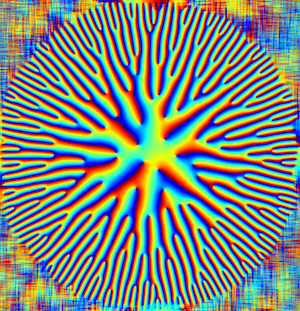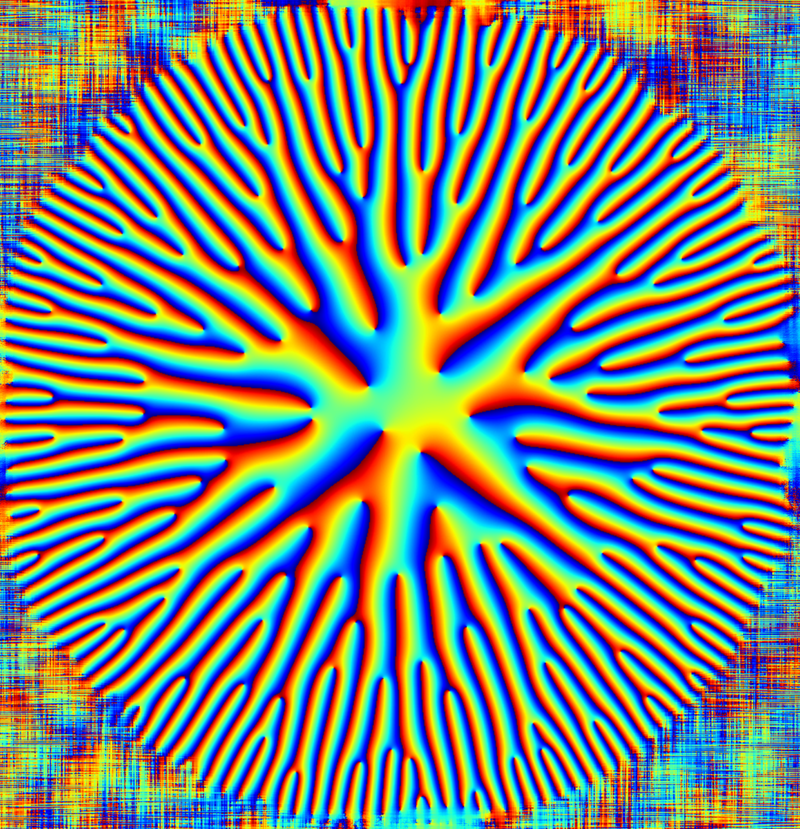Shake a Condensate to Spawn Dozens of Them
A Bose-Einstein condensate is a collection of atoms or other particles cooled to the point that they merge into a single quantum state with many special properties. In Physical Review Letters, theorists show that when a condensate is vigorously stirred up—for example, by a shaking force—the collection segregates into multiple condensates, but always an odd number of them. The results show that out-of-equilibrium quantum condensates can develop internal organization similar to that seen in some classical systems.
According to quantum mechanics, fundamental particles are categorized as either fermions or bosons, which interact differently. The affinity between bosons leads them at low temperatures to form a condensate, in which a large fraction of the group jointly occupies the lowest energy state. This behavior contributes to the spectacular properties of superconductors and superfluids but takes its purest form in ultracold atomic gases.
In recent years, researchers have explored these systems by poking and squeezing them in increasingly complex ways. André Eckardt and his colleagues at the Max Planck Institute for the Physics of Complex Systems and the Technical University of Dresden, Germany, wanted to explore theoretically how a condensate responds to a large, time-periodic force that drives it far from equilibrium—the condensate equivalent of continually shaking a can of nuts, so that they never settle. It turns out that the large energy being pumped in changes the nature of the quantum states. They can no longer be assigned energy values or “levels,” so there is no such thing as a ground state where all the particles can congregate. The discrete quantum states still exist, but they aren’t energy states.
Without energy states, the usual mathematics of condensation no longer works. So Eckardt and his colleagues instead turned to a set of rate equations, which specify, for every pair of states, how frequently particles jump between those states. For bosons, the rate at which particles enter a state is enhanced when particles are already in that state. (This enhancement is exploited with photons in lasers.) Apart from this enhancement factor, the researchers chose the rates randomly. They then numerically simulated the swapping of the particles among the states to see where the particles tended to accumulate.
If the system were at equilibrium, a large fraction of the particles would naturally occupy the single ground state. But in the driven system, the researchers found that particles wound up circulating among multiple states, with each one forming a separate condensate. According to the results, starting with a single condensate with mostly unoccupied states and applying the driving force would generate about condensates, all in the same region, with the particles constantly jumping from one condensate to another. When the team added new particles, they also found their way to these same states, since bosons tend to congregate.
At first, the researchers were surprised that the number of “selected” states was always odd. To explain this observation, and their other results, the team used a simplified theory that replaces the time-varying number of particles in a state with its time average. Within this theory, the team showed mathematically that if the number of states is even, some of the states will quickly become depleted of particles until the total number of heavily occupied states is odd.
An experiment that could test these ideas, Eckardt says, might be a condensate of exciton-polaritons—short-lived particles consisting of bound electrons and holes generated by a laser in a microscale semiconductor cavity. Instead of shaking, the external force in this case would be the continuous creation of new particles by the laser, but the team suspects that similar principles would apply.
“The paper makes a big connection,” says Martin Evans of the University of Edinburgh, UK, “between condensation in quantum bosonic systems and the condensation that’s seen in stochastic, classical systems.” The connection is that similar rate equations to those used by Eckardt and his colleagues can describe the behavior of collectively flowing objects such as beads going through a funnel or cars traveling on a highway. These systems spontaneously develop multiple dense jams that impede motion and are analogous to the multiple condensates. The selection of an odd number of states is “a curious thing,” says Evans, and challenges researchers to learn more about why some states are chosen.
–Don Monroe
Don Monroe is a freelance science writer in Murray Hill, New Jersey.





